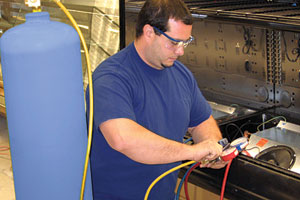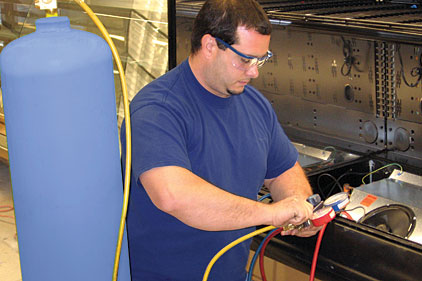
|
| Recovered refrigerant is another way for a contractor or system owner to generate revenue. It is important to follow best practices when recovering refrigerant to be able to financially benefit. |
There are a growing number of incentives being offered in the marketplace to increase the amount of recovered R-22 returned to reclaim. The Environmental Protection Agency (EPA) Final Rule projected that 20 percent of the service demand would be met with reclaimed R-22. But based on the amount of reclaimed R-22 reported to the EPA over the last several years, we continue to be short of that number.
In the past, processing the recovered gas was regarded as a possible cost for the contractor versus today’s view of the gas as an asset. The “it costs me too much” reason not to recover and return refrigerant from a system is no longer valid. The recovered gas is yet another way for the contractor or system owner to generate revenue. However, it’s important to follow best practices when recovering refrigerant to be able to financially benefit.
There are two options for contractors and equipment owners to ensure R-22 supply according to Section 608 of the Clean Air Act. System owners have the option to recover and reuse the R-22 to service their systems. The second option is to bring the recovered gas to a reclaim center to be reclaimed to the purity level specified in Air-Conditioning, Heating, and Refrigeration Institute (AHRI) Standard 700-2011. Once the refrigerant is reclaimed following the standard protocol, it may be packaged and returned to the marketplace.
As R-22 continues to be phased out, reclaim becomes a vital part of the R-22 supply. DuPont recommends recovery, recycle, and reclaim as part of good refrigerant management planning practices.
Recovery Steps
Basic steps for successful recovery include the following:
1. Recover into the appropriate pressure rated (psi) cylinder for the refrigerant in question. (DuPont has a Refrigerant Recovery Cylinder Guide that provides more detailed information, and is available at www.refrigerants.dupont.com/manage22.)
2. Before using, confirm that the recovery cylinder is within the five-year recertification date, and inspect for dents, corrosion, or any defect. Do not fill a cylinder that is past the periodic recertification date. However, if the cylinder was filled prior to the recertification due date, Department of Transportation (DOT) guidelines state that it is acceptable to return and transport the cylinder. (Reference: DOT 49CFR 173.301(a)(6)).
3. Don’t mix different types of refrigerants. This will impact the potential value of the recovered gas. Tag the cylinder to identify what refrigerant type is in the cylinder. Refrigerant that is mixed or has a low purity level potentially may not be brought back to AHRI standards and may incur a destruction fee from a reclaim provider. Also, purge recovery equipment including hoses after each recovery session.
4. Do not overfill the recovery cylinder. Weigh the cylinder before and after each recovery job. A best practice is to not fill a cylinder above 80 percent liquid full at 77° F. Refer to the recovery cylinder manufacturer for specific recovery cylinder fill weight information. It should also be noted that liquid refrigerant will expand as its temperature is increased. The pressure can increase dramatically with a relatively small increase in temperature and could pose a hazard if the cylinder somehow becomes completely full of liquid.
5. Avoid placing a filled recovery cylinder in direct sunlight or temperatures exceeding 125°F. or 52°C. Also, avoid open flame, or exposure to heat.
Reclaim Process
The process for reclamation, and protecting the value of the recovered refrigerant, begins with the contractor/technician. Here are the steps:
1. Contractors obtain empty recovery cylinders from their refrigerant wholesaler/reclaim center. The contractor tags or identifies the cylinder with the refrigerant type that is being put into the cylinder. After recovering and filling the cylinder to 80 percent liquid full, the contractor returns the filled cylinders and swaps for an empty recovery tank at their reclaim center. A nominal fee may apply.
2. The reclaim center consolidates, palletizes, and ships the minimum recovered refrigerant return quantity — typically 500-600 pounds — to the reclaim facility. A hazmat trained employee is responsible for following proper DOT and Occupational Safety and Health Administration (OSHA) requirements for used refrigerant.
3. The reclaim facility receives the shipment and documents the return into a database including the refrigerant contents and cylinder details.
4. Analysis is conducted on each cylinder using a two-step process that consists of an infrared refrigerant identifier followed by gas chromatography/mass spectrometry conducted by an AHRI-certified lab.
5. Once the refrigerant reclamation process is completed, a detailed analysis report is issued for each unique cylinder that includes cylinder ID number, refrigerant type, purity, and gross/net weights before and after reclamation. Refrigerant reclamation involves purifying used refrigerant and verification by chemical analysis to meet industry product specifications based on AHRI Standard 700-2011. (This most recent AHRI standard version is available to download at www.ahrinet.org/search+standards.aspx.)
6. At that point, the contractor receives either payment for the recovered refrigerant and/or access to the reclaimed refrigerant at a reduced price. Options vary based on the reclaim center’s specific program. In addition, individual reports for specific contractors or equipment owners are available to meet recordkeeping requirements.
Sidebar: DuPont’s Reclaim Program
DuPont’s reclaim program is through participating wholesalers who tailor their offering to meet the needs of contractors and system owners. These Authorized Refrigerant Reclaim Centers handle all recovered refrigerants sent for reclaim and/or destruction in an environmentally responsible manner according to EPA requirements under Section 608 of the Clean Air Act.
Information on the closest location in this program can be accessed at www.refrigerants.dupont.com/manage22. In addition, DuPont promotes Recla-fit™, a combination of reclaim and retrofit, to a non-ozone depleting refrigerant like R-438A (which DuPont markets as ISCEON® MO99™).
Publication date: 12/24/2012


Report Abusive Comment